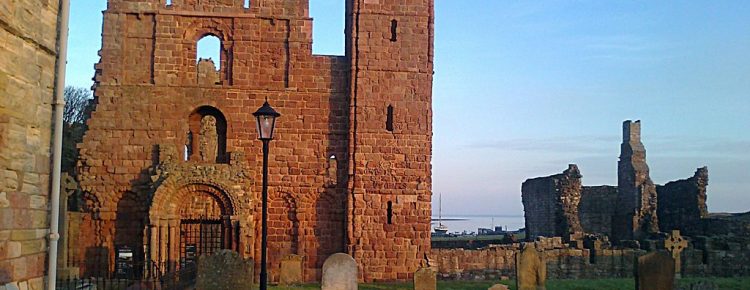The remains of an Anglo-Saxon church have been discovered on the Holy Island of Lindisfarne in Northumberland. A community excavation has uncovered a church nave, chancel and an altar base built of sandstone blocks on a ridge called the Heugh and experts think that it was part of the long lost Celtic abbey where St. Aidan raised a wooden church in A.D. 635. Accounts of the excavation are HERE and HERE.
St. Aidan was invited to establish a monastery on Lindisfarne by King and Saint Oswald of Northumbria, whose castle was nearby at Bamburgh. Northumbria was the first of the great Anglo Saxon kingdoms and included Lancashire. The Vikings subsequently destroyed the monastery and its original location was lost for over a thousand years. The present day monastic ruins in the photo above belong to a much later medieval replacement priory. In fact, this excavation is the very first indication of where the Saxon abbey was sited – hence the excitement.
 The Saxon mother church of Oswaldtwistle is Church Kirk, now sadly made redundant. It was originally dedicated to St. Oswald as it was founded on the site where the King set up his camp on his way to Oswestry in 642, where he was martyred. Like many churches of great antiquity, its dedication was later changed following the needs and fashions of the time, in this instance to St. James. St. Oswald’s, Knuzden was dedicated to redress the balance and to remind everyone of the Northumbrian associations and ancient dedication to St. Oswald of this historic area of Lancashire.
The Saxon mother church of Oswaldtwistle is Church Kirk, now sadly made redundant. It was originally dedicated to St. Oswald as it was founded on the site where the King set up his camp on his way to Oswestry in 642, where he was martyred. Like many churches of great antiquity, its dedication was later changed following the needs and fashions of the time, in this instance to St. James. St. Oswald’s, Knuzden was dedicated to redress the balance and to remind everyone of the Northumbrian associations and ancient dedication to St. Oswald of this historic area of Lancashire.

